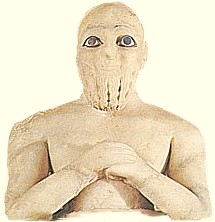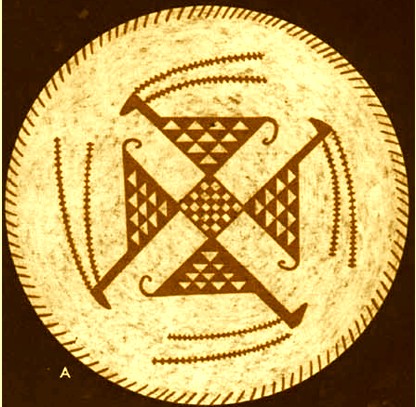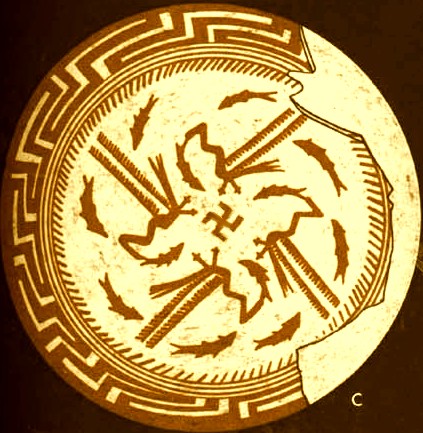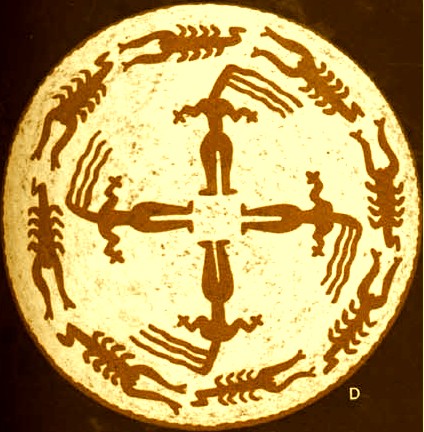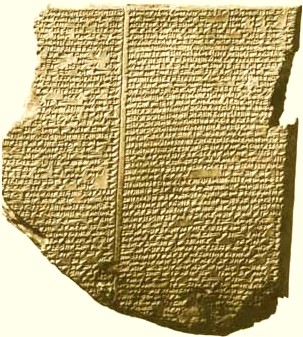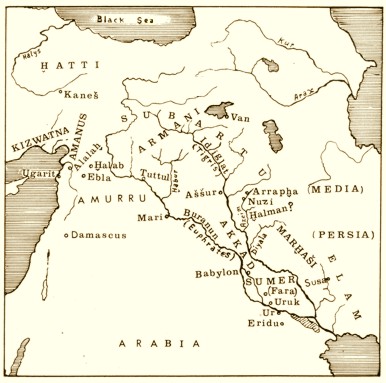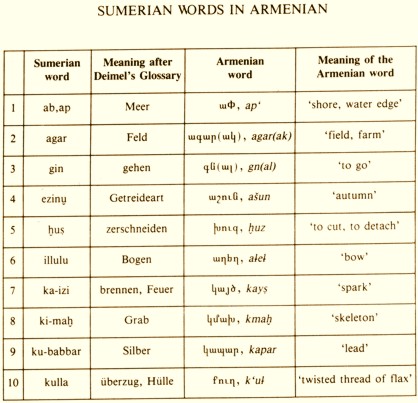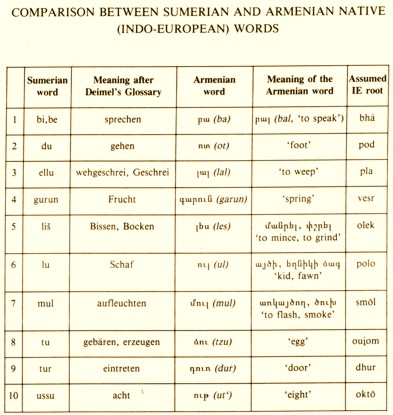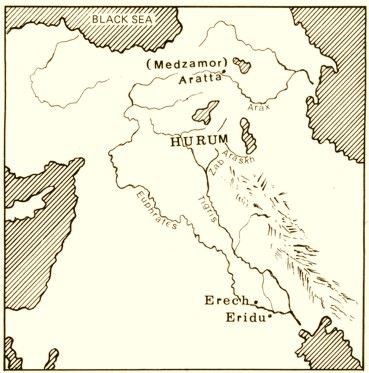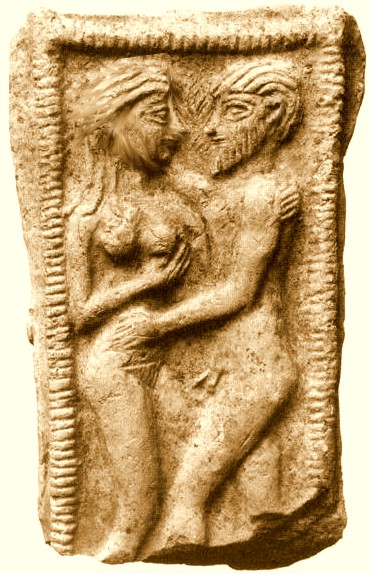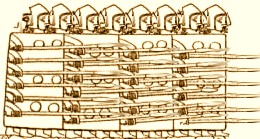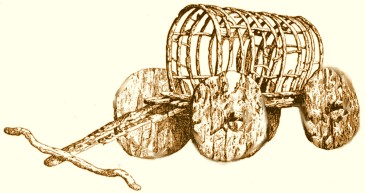For thousands of years, the legend of a great flood has endured in the biblical story of Noah and such Middle Eastern myths as the epic of Gilgamesh. Few scientists believed that such a catastrophic deluge had actually occurred. But these Bible “stories” for some scientific people appeared to have a real sense . Considering that religion and science have to work together, two distinguished geophysicists have discovered an event that changed history; a sensational flood 8,600 years ago in what is today the Black Sea.
Not only in the Bible have we found stories about the flood, but also in ancient clay tablets excavated from the ruins of biblical Nineveh more than a hundred years ago. These tablets revealed a much older version of the same flood legend. Archeologists searched the length and breath of the Tigris and Euphrates rivers in Mesopotamia for evidence of such a flood, to no avail. Then, as earth scientists made new discoveries about the history of rapid climate change, they learned that the Mediterranean Sea had once been a desert and 5,000,000 years ago the Atlantic Ocean burst through the Strait of Gibraltar and refilled the Mediterranean basin. William Ryan and Walter Pitman posed the scientific question “ Could some more recent , similar catastrophe have been the source of Noah’s Flood ?”
The end of the Cold War enabled Ryan and Pitman to team up with oceanographers from Bulgaria and Russia, as well as Turkey , to explore the Black Sea . Using sound waves and coring devices to probe the sea floor, they discover clear evidence that this inland body of water had once been a vast freshwater lake lying hundreds of feet below the level of the world’s rising oceans.
In 12,500 B.C., the earth’s temperature increased and the Eurasian ice sheet started to melt. The level of sea and oceans increased by 150 meters. The England peninsula become an island.
The Atlantic Ocean water burst again through the Strait of Gibraltar and refilled the Mediterranean basin. Increases of the Mediterranean Sea level to 150 m. had a disastrous consequence. Huge pieces of land being flooded, sank. One example being the piece of land that was linking the Balkan peninsula with Turkey which disappeared giving birth to a new sea, the Thracian Sea, later known as the Aegean sea and a lot of new islands . Strange cultures and very advanced civilizations were left in these islands. Some of these islands were actually the mountain tips of all that remained unsubmerged which proved that this piece of land was an important corridor of civilization that linked Europe and Asia. Suddenly the legend of lost Atlantica started to become more realistic.
Sophisticated dating techniques, sometimes using both the carbon 14 and a new method of Thermal Ionization Mass Spectrometry ( TIMS) confirmed that 8,600 years ago the mounting seas had burst through the narrow Bosporus valley , and the salt water of Mediterranean had poured into the lake with unimaginable force, racing over beaches and up rivers , destroying or chasing all life before it. The margins of the lake , which has been a unique oasis, a Garden of Eden for an advanced culture in a vast region of semi-desert , became a sea of death.
Biblical Noah’s Flood is solidly grounded in contemporary science. It is an astonishing religious story that sheds new light on our roots and gives fresh meaning to ancient myths.
If there was ever a time when our kind did not think, then it was also a time when we did not speak. Thus, it was also a time when we did not write, either. How long ago that must have been, we can only guess: but it was so long ago that, by definition, we would no longer be referring to what we consider ourselves to be. It is possible to think without words, and on the same token it is not possible to speak without language. But what makes us what we are today is witting.
Neither speaking nor thinking or writing arose fully formed. The development of both was an ongoing, incremental task which has yet to find a final point of development. New thoughts, and new words, continue to be produced; and as far as we can tell, the productive expression of human thought will not achieve an end state for as long as people exist. From what we can see, the future of thought and of speech stretches far further ahead of us than it does behind.
At a first glance, this seems to be particularly true of the specific form of linguistic expression that we call writing. The earliest examples of a written form date back about 7,500 years, to around 5,500 B.C. relating to what today is known as Tartaria tablets.
We can reasonably assume that thinking and speaking go back much farther than that; but such activities leave no permanent trace and so, we conclude that most of what we humans might have thought and said for most of our collective history has been lost to us in the irretrievable depths of time beyond memory until the witting appeared.
Our oldest written texts are among our most treasured artifacts and unlike other remnants of our past; they are still being use today much as they were when they were first created. Indeed, such ancient texts are more widely read now than they were when first penned.
Of course, the technological advances that we might expect of 2,500 A.D. are far and away beyond anything we can imagine; but then, the technological advances of 2001 A.D. are far beyond what could have been conceived of in 5,500 B.C.
Would the written records of life in 2004 A.D. be of interest to people in …5,500 A.D.? Quite probably, they would be considered to be utterly fascinating.
Does it make any sense then for us in 2004 A.D. to ignore written records that date from 7,500 years ago, if we could still find and read such recorded experience?
Whatever form of written communication in the year 5,500, it will in all probably be very different than the phonetic forms of writing we use today.
It is not surprising then, that the form of writing used 7,500 years ago was very different than phonetic script. When writing began, it started as a form of communication which was essentially different than speech. Today, we write down the words which we speak, but 7,500 years ago, people wrote down their ideas as expressed in terms of their perceptions. This approach to writing has numerous advantages over phonetically-based writing systems: for one, since our senses are innate, such a form of writing can be understood by anyone without them having to learn any specific form of spoken language or phonetically-based writing.
Writing provides a way of extending human memory by imprinting into media-less fickle than the human brain. However, many early philosophers, such as Plato, have branded writing as a detriment to the human intellect. They argued that it makes the brain lazy and decreases the capacity of memory. It is true that many non-writing cultures often pass long poems and prose from generation to generation without any change, and writing cultures can't seem to do that. But writing was a very useful invention for complex and high-population cultures. Writing was used for record keeping to correctly count agricultural products, for keeping the calendar to plant crops at the correct time. Writing was also used for religious purpose (divination and communicating with the supernatural world) and socio-political functions (reinforcing the kingship).
However, writing isn't an absolute requirement of urban culture. In the past centuries, scientists had used writing as one of the "signs" of civilization, which is an incorrect assumption. The Incas and earlier Andean civilizations never developed a writing system. They, in turn, came up with interesting solutions: they used the quipu (a series of ropes with knots indicating amounts) for record keeping, and complex tapestries as calendars. The Mississippians who built Cahokia didn't seem to have used any kind of record keeping at all, but they built very impressive cities in the American Midwest.
In ancient Egypt, for example, the invention of writing is attributed to the god Thoth (Dhwty in Egyptian), who was not only the scribe and historian of the gods but also kept the calendar and invented art and science. In some Egyptian myths, Thoth is also portrayed as the creator of speech and possessing the power to transform speech into material objects. This ties in closely with the Egyptian belief that in order for a person to achieve immortality his or her name must be spoken or inscribed somewhere forever.
In Mesopotamia, among the Sumerians, the god Enkil was the creator of writing. Later during Assyrian, and Babylonian periods, the god Nabu was credited as the inventor of writing and scribe of the gods. And similar to Thoth, Mesopotamian scribal gods also exhibit the power of creation via divine speech.
Among the Maya, the supreme deity Itzamna was a shaman and sorcerer as well as the creator of the world. (In fact, the root of his name, "itz", can be roughly translated as "magical substance, usually secreted by some object that sustains the gods"). Itzamna was also responsible for the creation of writing and time-keeping. Strangely enough, though, Itzamna isn't a scribal god. This duty falls on usually a pair of monkey gods as depicted on many Maya pots and is also preserved in the highland Maya epic "Popol Vuh". Still, in one rare case, the scribe is a rabbit.
In China, the invention of writing was not attributed to a deity but instead to an ancient sage named Ts'ang Chieh, who was a minister in the court of the legendary Huang Ti (Yellow Emperor). While not divine, this invention occurred in mythological times, and served as a communication tool between heaven (realm of gods and ancestors) and earth (realm of humans), as demonstrated by the inscribed oracle bones used for divination during historical times.
Whether as a medium to communicate with the gods, or as a magical or supernatural power, writing clearly possessed a divine nature in these ancient cultures. Hence, writing became not only a way to extend memory but also a tool for the elite to justify their rule upon the common, illiterate people.
The Vinca civilization in Europe was one of the earliest urban societies to emerge in the world, in Southern Charpatian aria more than 7,500 years ago. They developed a writing system whose wedge-shaped strokes would influence the style of scripts in the same geographical area for the next 3000 years.
It is actually possible to trace the long road of invention of the Vinca writing system starting with the mysterious Tartaria tablets from Transylvania, Dacia, known today as Romania.
What explanation can be given to the fact that three clay tablets
containing Sumerian pictographic writing, made with local clay , but at least 2,500 years older than the oldest tablets found in Mesopotamia , are found in a region where the surrounding cities have Sumerian names , URASTIE , SIMERIA , KUGIR ? Is it impossible that Sumerian groups have migrated as far north as the western present-day Rumania, because at that time they did not exist!
Today the Tartaria tablets are included in the "Vinca" culture. Being familiar not only with Maria Gimbutas’s remarkable work and Milton McChesney Winn 1973 University of California Los Angeles, but also with Ryan and Pitman reechoes, the conclusion is that these three clay tablets are a pre- Sumerian writing, make sense.
It is impossible other wise to explain the similarities especially the fact that they contain pictograms absolutely identical with those found in Djemet-Nasr ,and to be dated 2,500 years before the Summer to exist ! Today the problem that the inclusion of just these three tablets in the "Vinca" culture seems unrealistic. Others tablets and a lot of artifacts have been found as part of it, belonging indeed to a proto-European culture, Danubian culture, that is more widespread than it is ascertained today .
The inscribed artifacts were used both by the common people in domestic rites and by a powerful priestly elite during magical and Religious ceremonies. According to some authors, when celebrating burial rites; e.g. the inscribed Tartaria tablets accompanied the charred bones of an individual in a grave.
“The reorganization of religion and the invention of a script, see Tartaria tablets were basic elements of the long period of transition
Experienced by the populations of south-east Europe, of which many aspects are still unknown to us today.”(Harmann, 1997 and Merlini 2002)
These include not only the Tartaria but also Turdas tablets from Transylvania (studied by N. Vlassa and others), the artifacts of the Vinca cultural area in Serbia (studied, notably, by Shan Winn), and isolated objects from Bulgaria such as the Gradesnica plaque and the much-discussed (and variously interpreted) Karanovo Seal.
Had south-west neolithic Europe developed its own script 2,500 years before the Sumerians and Egyptians?
A mother on a throne holding a child in her arms was found in a small village called, Rast, in western Romania which belonged to the Vinca culture. Both figures are covered with strange geometrical and abstract motifs that suggest , accordenly to marija Gimbutas, writing. This is astonishing, because this "Madonna" is over 7000 years old
In Romania on Ocna Sibiului territory, at "Triguri" - a high terrace of Visa brook, situated near the old salt mines (the present lakes) - has identified one of the largest Neolithic (since 1977). Within the settlement, there were findings of six successive habitation levels, marked by pit houses and surface dwellings. In this context, was discovered a new "cult assemblage", unique until the present day in this part of the ancient world. It contained a
statuette and a pedestal bear with certain incised-engraved signs, which, according to their shape and elaborated disposal, seem to represent symbols and ideograms made in a linear manner. The only known analogy is represented by a statuette chiseled in lune spar which was discovered a while ago in the sanctuary no. 21 from the VIIth layer of the Çatal Hüyük settlement, Anatolia (J. Mellaart 1963, fig. 18). According to the C14 method, the layer , in Romania , has been dated between 6200-6500 B.C. (Antonova 1977, p. 21).
Also in Romania, (Sibiu Museum) a 7500-year-old phallus, was carrying an inscription in the lost proto-European script that has never been deciphered.
These symbols have been found on many of the artifacts excavated from sites in south-east Europe, in particular from thevVinča culture, in Romania, Greece, Bulgaria, eastern Hungary, Moldova, southern Ukraine and the former Yugoslavia. The artefacts date from between the 7th and 4th millennia BC and those decorated with these symbols are between 8,000 and 6,500 years old.
Many scholars today consider that the Vinča symbols represent the earliest form of writing ever found, predating ancient Egyptian and Sumerian writing by thousands of years. Since the inscriptions are all short and appear on objects found in burial sites, the language represented is not known and it is highly unlikely they will ever be deciphered.
Signs are incised on pottery, spindle whorls, figurines and other clay artifacts. The signs are not components of ornamental motifs, although a few examples are abstractions from decorative prototypes.
A sign may occur as a single, isolated sign on an otherwise unmarked area, or as a component of a sign group.
This study includes correlations of sign usage according to context - pottery, figurines, spindle whorls, miniature vessels, "tablets" and artifacts of undefined use.
Signs found in isolation frequently appear on pottery and occasionally on figurines, but rarely on spindle whorls.
Signs on pottery were analyzed according to their location on the vessel: (a) rim/upper body; (b) side near base; and (c) base.
Certain signs, including
are inscribed anywhere on the vessel; they are also found in sign groups and, indeed, later appear as script signs in the Mediterranean. Pictographic signs and symbolic elements are generally located on highly visible portions of the vessel:
At Turdos, pictographs, or abstractions from them, are common; they are occasionally placed on the base, perhaps as information or to facilitate sign recognition on vessels that were inverted when stored.
A few signs seem to be restricted to the lower side of vessels, where they are not readily visible unless one intentionally observes the basal angle of the vessel. At certain sites, such as Medvednjak and Banjica, many of these are unique signs and may identify the owner or producer:
Signs suggesting the utilization of a numbering system appear on the base or on the lower side adjacent to the base:
Many of the Turdos signs restricted to the base are distinctive; such signs frequently are thought to denote identification of contents, provenience/destination or manufacturer/owner.
However, basal signs are frequently zoomorphic representations,
Comb or brush patterns
And symbols.
A specialized category confined to the base is a type of filled cross
which is generally divided into symmetrically arranged quadrants. A similar arrangement is often found on stamp seals or artifacts considered to have cultic usages.
Certain signs are randomly placed on pottery but are excluded from the base. Most of these
appear commonly on figurines and may refer to a different sign subset dependent on other contexts.
Particularly common representations on figurines are triple chevrons, 6 chevrons or 6 parallel lines; such arrangements probably reflect an ideological feature of the Vinča cultural template. Distinctive figurine signs
found at several sites perhaps may signify specific concepts, personal identifications, or even an attempt to acquire magic-religious powers during rituals associated with specific figurine usage.
Similar signs are also found on spindle whorls and are sometimes randomly placed on pottery.
In short, the distribution of single signs contradicts the notion that the Vinča signs are merely owner's or maker's marks
But why should the proto-European farmers have started writing things down? Around 10,000-9000 years ago, some tribes of hunters and gatherers from the west coast of the what is so call today Black Sea , that time a vast freshwater lake, began to use new techniques, and started to produce animal and human figures, pottery, copper and other metal artefacts. They also built palaces, temples and ships and creating weaving techniques. A sensational flood 7,600 years ago in what is today the Black Sea a catastrofic event, changed their history and the history of humanity. The so call black sea peolpe fled , dispersing their language, genes, memory and their writting, not only West and North-West of Europe, but also to Asia and South-East into the Levant, Egypt and Mesopotamia ( see W.Ryan & W.Pitman, Noah’s flood, p.189-194, Touchstone, New York,1998).
1.One group of farmers called “Linear-band-Keramic”,(LBK), a name derived from their distinctive style of pottery, appeared in Europe within a century an a half after the flood, in mid sixth millennium B.C., rapidly occupying an arc from the Dniester River across northern Europe as far as the Paris basin, displacing the indigenous hunter-gatherers. To a number of experts the spread of the LBK culture along this arc reflects colonization by farming population in such a brief period of time that its beginning and end are at present irresolvable by the radiocarbon dating methods. They brought with them their longhouse building style, never before seen in Europe; these huge timber-frame houses, up to 150 feet in length, were organized into villages founded exclusively on the fertile soil blown across Eurasia during the sky-darkening sandstorm of the last Ice Age. The LBK pottery was decorated almost exclusively with incised patterns grooves and bands of dotted lines forming spirals, waves, concentric rectangles, and other geometric designs, almost all without applied color. Experts specializing in pottery can readily recognize shards from Moldova as if they had been crafted nearby in France. Their explosive movement from east to west up the Dniester and Vistula rivers, and across the Rhineland to the valley of the Seine has only recently been recognized as a mass immigration, almost an invasion of the Europe by the Black Sea people, by LBK people.
2. Simultaneously with the appearance of the LBK, the Vinca emerged abruptly on the plains of what is knowing today as Romania, Bulgaria, Macedonia, Ungaria, settling on the river terraces. They constructed well-planned permanent villages on leveled ground with parallel rows of houses separated by streets. They plastered their house floors with white clay and build them from split timber planks, instead of mud-brick, in contrast to prior population. Their art and pottery at Vinca were exceptional, in total contrast with the prior civilization.
3. The Danilo-Havar (DH) people settled along the Adriatic coast of Dalmatia in several of the fertile valleys that cut through the mountains to the sea, strategically located at the seaward end of the Neretva River valley. DH pottery was sophisticated decorated with rich patterns of chevrons, spirals, running waves, nested S’s, and other geometric figures, sometimes painted in black and red. They crafted a now-famous pot decorated with a sailing ship, dated at about 4,000 B.C.
4. People called Hamangians also seemed to emerge out of nowhere to settle in the region of south-east costal Romania. Two fascinating and quite modern-looking sculptures from early in the fifth millennium B.C. were found together in a grave (Hamangia-Romania), the “Thinker” and his wife. Without the new concept of the Danubian culture, mother of the European civilization and without the new knowledge about the Black Sea flood, it would be difficult to explain the Hamangians sculptures. It was suggested, on the basis of their splendid sculpting, their use of marble, and the presence of spondylus shells, that they were immigrants from the area of Levant or somewhere else in southwest Asia. It is too easy to say that they belonged to the Black Sea fresh water lake people, but it makes sense. Perhaps not so coincidentally, at that time in the middle of the VI-th millennium B.C., Europe began a rapid ascent into what Childe and Gimbutas have called “The Golden Age of Europe”. It has been nothing more then the forced exodus of more advanced people from a grand melting pot in the wake of a Grand Flood that gave the culture of Old Europe its thrust to a “Golden Age”.
5. The proto Indo- Europeans
6. The Ubaids people/civilization
7. Pre-semitic vs. Semitic people
8. Pre dynastic Egyptians
All of the above could be groups of fresh water Black Sea people migrating all over as a flood consequence.
The people fled, never to return.
Today scientific people explore the exiting archeological , genetic, and linguistic evidence suggesting that the flood rapidly created a human diaspora that spread as far as Western Europe , Center Asia, China, Egypt, and the Persian Gulf. They suggested that the Black Sea People could well have been the mysterious proto-Sumerians who developed the first great civilization in Mesopotamia.
Antonova, E.V., 1977 - Antropomorfaia sculptura drevnih zemledelcev Drevnei i Srednei Asii, Moscova, 1977, p. 22, pl. VII, I.
Carciumaru, M., 1987 - Marturii ale artei rupestre preistorice în România, Bucuresti, 1987, p. 136-137, fig. 49.
A. Deimel, Die Inschriften von Fara I: Liste der archaischen Keilschriftzeichen, WVDOG 40, Leipzig 1922.
R. K. Englund & J.-P. Grégoire, The Proto-Cuneiform Texts from Jemdet Nasr, Gebr. Mann Verlag, Berlin, 1991.
Giumbutas M, The Language of the Goddess, San Francisco, 1989. Trad it. Il linguaggio della Dea, Longanesi, 1990
Gimbutas M., The Civilization of the Goddess, San Francisco, 1991.
M.W. Green and H.J. Nissen, Zeichenliste der Archaischen Texte aus Uruk [ZATU] (Ausgrabungen der Deutschen Forschungsgemeinschaft in Uruk-Warka, 11; Archaische Texte aus Uruk, 2); Berlin 1987.
Haarmann H., Early Civilization and Literacy in Europe. An Inquiry Into Cultural Continuity in the Mediterranean World, Berlino, New York, 1995.
Haarmann, H., The development of sign conceptions in the evolution of human cultures, in: Posner et al., "A Handbook on the Sign-Theoretic Foundations of Nature and Culture", Berlin, 1997
Haarmann, H., On the Nature of Old European Civilization and its Script, in "Studia Indogermanica Lodziensia" vol II, Lódz, 1998
Hokmann, O., 1968 - Die menschengestaltige Figuralplastik der südost-europäischen Jungsteinzeit und Steinkupferzeit, in Münstersche Beiträge zur Vorgeschichtsforschung, Band 3-4, 1968, vol. I, p. 5, vol. II, pl. 1, 30.
Leroi-Gourhan, A., 1964 - Les religions de la préhistoire, Paris, 1964.
Leroi-Gourhan, A., 1987 - Gestul si cuvântul, Bucuresti, 1987.
Marler J. (a cura di), From the Realm of the Ancestors: An Anthology in Honour of Marija Gimbutas, Manchester (Conn.), 1997
Marler J., L'eredità di Marija Gimbutas: una ricerca archeomitologica sulle radici della civiltà europea, in Bocchi e Ceruti "Le radici prime dell'Europa", Milano. 2001
Marshack A., The roots of civilization: the cognitive beginnings of man's first art, symbol and notation, New York 1972, seconda ediz. riveduta 1992
Mellaart, J., 1963 - Excavations at Çatal Hüyük, Second Preliminary Report, in Anatolian Studies, vol. XII, 1963, fig. 18.
Merlini M., Prehistory Knowledge Project data base, Rome, 2001.
Merlini M., “On the Origins of Old European Writing”, in World IFRAO Congress 2002, Skopje, 2002a
Merlini M., “A Neolithic Writing System in Southestern Europe”, in World IFRAO Congress 2002, Skopje, 2002b
Merlini M., Was Writing Born in Europe? Searching for a Sacred Script, Rome Parpola A., Deciphering the Indus script, Cambridge, 1994
Paul, I., 1995 - Vorgeschichtliche untersuchungen in Siebenbürgen, Alba Iulia, 1995, p. 135-146.
Y. Rosengarten, Répertoire commenté des signes présargoniques sumériens de Lagas, Éditions E. de Boccard, Paris, 1967.
Ruttkay E., Ein Lengyel-Löffel mit Ideogramm aus Wetzleinsdorf, Niederösterreich, Festschrift für V. Podborský, SPFFBU M2, 1997
N.Savescu., Noi nu suntem urmasii Romei, www.dacia.org
P. Steinkeller, review of M.W. Green and H.J. Nissen, Bibliotheca Orientalis 52 (1995), pp. 689-713.
K. Volk, A Sumerian Reader, vol. 18 in Studia Pohl: Series Maior; Rome 1997 (this practical, inexpensive book includes a nice, though incomplete, sign-list).
Winn M.M., Pre-writing in Southeastern Europe: The Sign System of the
Vincha Culture ca 4000 BC, Calgary, 1981
Winn M.M. A Neolithic Sign System in Southeastern Europe, in M. Le Cron Foster, L. J.Botscharow "The Life of Symbols", San Francisco 1990
Dr. Naploeon Savescu
